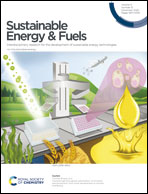A MOF derived Co-NC@CNT composite with a 3D interconnected conductive carbon network as a highly efficient cathode catalyst for Li–O2 batteries†
Abstract
Lithium–oxygen batteries are considered to be one of the most promising next-generation energy storage devices due to their ultra-high theoretical specific capacity and relatively simple structure. Herein, Co-NC@CNTs with a 3D interconnected conductive carbon network were synthesized. Co-NC nanoparticles derived from ZIF-67 as carbon network nodes have micro/mesoporous structures, as well as rich Co species catalytic sites for the oxygen reduction reaction (ORR) and oxygen evolution reaction (OER). And CNTs as carbon skeletons transfer electrons to enhance the conductivity. Additionally, the interconnected carbon network provides abundant space for accommodating the discharge products and prevents the reduction of catalytically active sites. Therefore, Co-NC@CNTs as a cathode catalyst for Li–O2 batteries show a high initial discharge capacity of 12572.2 mA h g−1 at 200 mA g−1, good rate capability (5865 mA h g−1@1000 mA g−1), and excellent cycling stability (145 cycles at 250 mA g−1) superior to that of Co-NC and pure CNT cathodes. This study provides effective approaches to design and fabricate promising cathodes to improve the performance of Li–O2 batteries.



 Please wait while we load your content...
Please wait while we load your content...